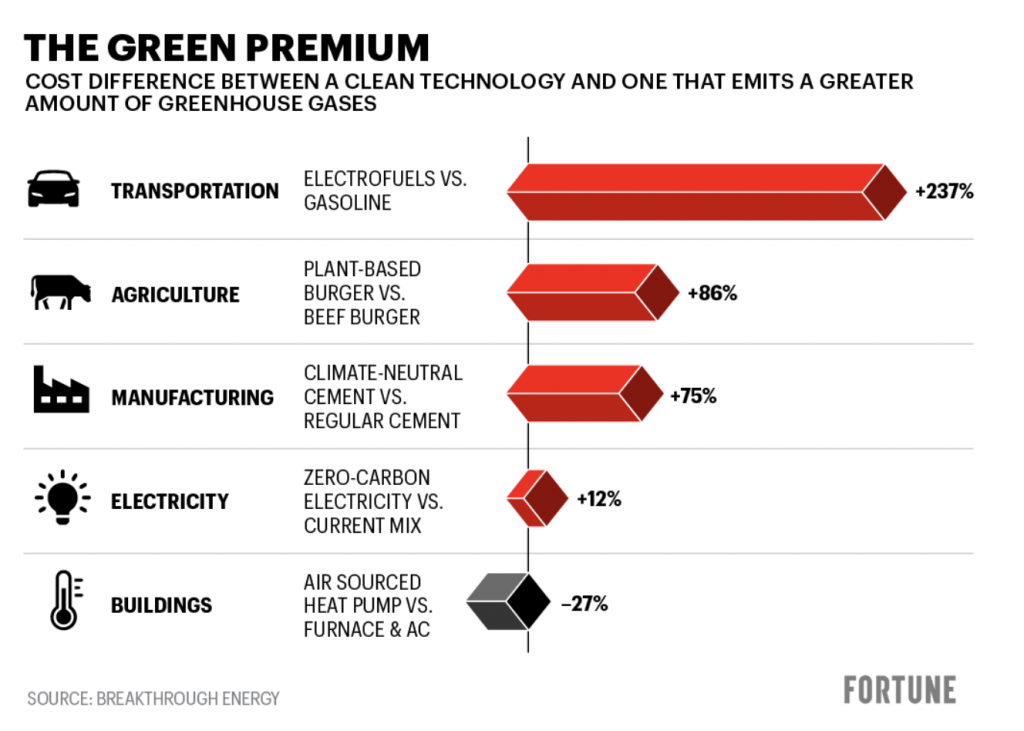As the world turns its focus towards reducing carbon emissions, the “green premium” concept has come to the foreground after Bill Gates, the billionaire philanthropist and founder of Microsoft, introduced it to a broader public in his latest book, How to Avoid a Climate Disaster. The green premium refers to the extra cost associated with adopting renewable energy and other environmentally-friendly technologies compared to alternatives that emit more greenhouse gasses.
For example, say you decide to purchase an electric vehicle (EV) instead of a traditional fossil-fuel powered car, and the EV is more expensive than an equivalent gasoline car then this difference in cost represents the green premium.
In practical terms, if the EV costs 40,000 EUR and the gasoline car costs 30,000 EUR, the green premium for the EV would be 10,000 EUR. This premium reflects the cost of the environmentally friendly technology used in the car, such as the battery, as well as the research and development costs associated with creating the technology.
Green Premium: The extra cost of using green-friendly technology#TheClimatePandemic pic.twitter.com/e5SJjrFbyk
— NDTV (@ndtv) February 15, 2021
Knowing the size of a green premium can help greatly in identifying which areas need more research and development and investments so that the premium can be brought down as much as possible and therefore provide a further incentive for consumers to choose the environmentally friendly alternative.
In fact, although the green premium concept appears to be an indication of the extra costs of transitioning to a low-carbon economy, the ability to calculate these premiums across different areas of the economy is also an opportunity as it helps provide clear signals on where and how to invest resources most effectively.
According to Fatih Birol, Executive Director of the International Energy Agency (IEA), “The green premium is a challenge that needs to be overcome if we want to reach our climate targets.” In a report published by the IEA in May 2021, the organization estimated that to achieve net-zero emissions by 2050, global investments in clean energy technology would need to increase from 2 trillion USD per year to 4 trillion USD per year.
Furthermore, green premiums have to be lowered as much as possible so that emerging economies can also enact low-carbon policies across various industries for a just transition that leaves no one behind. This means that policies and investments must be made to ensure that the costs of the green premium are not disproportionately borne by marginalized communities or developing countries.
Why is there a green premium?
One of the main reasons for the green premium is that fossil fuels have been heavily subsidized for decades, whereas renewable energy sources are emerging technologies and are often still in the infant stage.
However, this is beginning to change. In a speech at the 2021 Clean Energy Ministerial, John Kerry, the United States Special Presidential Envoy for Climate, stated that “The truth is that today, more and more, renewable energy is cheaper than its fossil fuel counterparts.” This is due in part to the falling costs of renewable energy technologies such as solar and wind power.
While the green premium may be a challenge, many experts believe that the benefits of transitioning to a low-carbon economy far outweigh the costs. In a report published by the Climate Policy Initiative, it was found that “the net benefits of a low-carbon transition can outweigh the costs, even in the short term, if the right policies are put in place.”
In an interview with CNBC, Gates emphasized the importance of addressing the green premium and reducing the cost of clean energy: “The thing that’s most important is to get the R&D [research and development] budgets up so that we can get the green premiums down. Right now, electric cars, green hydrogen, and many industrial processes still have a green premium. And until we get that down, they’re not going to be as attractive as the old ways of doing things.”
Identifying where and how large the green premiums on a low carbon transition can provide invaluable information as to where and how to enact policies that can ultimately lead to benefits such as reduced air pollution, improved public health, and increased job creation in the renewable energy sector.

Source: Fortune
Costs and benefits
Calculating the green premium is not always a straightforward task, and what is factored into the calculation leads to very different results. For example, including negative externalities of fossil fuel technologies, and hence the cost of their impacts on the environment and society, can make the cost of traditional technologies higher than they would otherwise appear.
One way to address this issue is using carbon pricing. Carbon pricing involves putting a price on carbon emissions, which creates an economic incentive for companies to reduce their emissions. In a report published by the World Bank, it was found that carbon pricing can play a critical role in driving the transition to a low-carbon economy while generating revenue for climate action.
Gates has also been a proponent of carbon pricing as a means of addressing the green premium. In a 2019 blog post, he wrote: “The world needs to start pricing carbon. When governments put a price on carbon, it creates an incentive for everyone to reduce their emissions. In industries like electricity generation, where there are many options for how to produce power, a carbon price will encourage the use of the low-cost, low-emissions options.”
Another method that has been used in the energy sector is renewable energy certificates (RECs). RECs represent the environmental attributes of renewable energy and can be purchased by companies to offset their own carbon emissions. In a report published by the Environmental Defense Fund, it was found that “RECs can provide a cost-effective way for companies to reduce their carbon footprint and support the growth of renewable energy.”
While it may be costly in the short term, the benefits of a low-carbon transition can far outweigh the costs. However, it is important to ensure that policies and investments are made to ensure that the green premium is not disproportionately borne by marginalized communities or developing countries. This can be achieved using carbon pricing, international cooperation, and investment, as well as targeted policies to support those who may be most affected by the transition.






